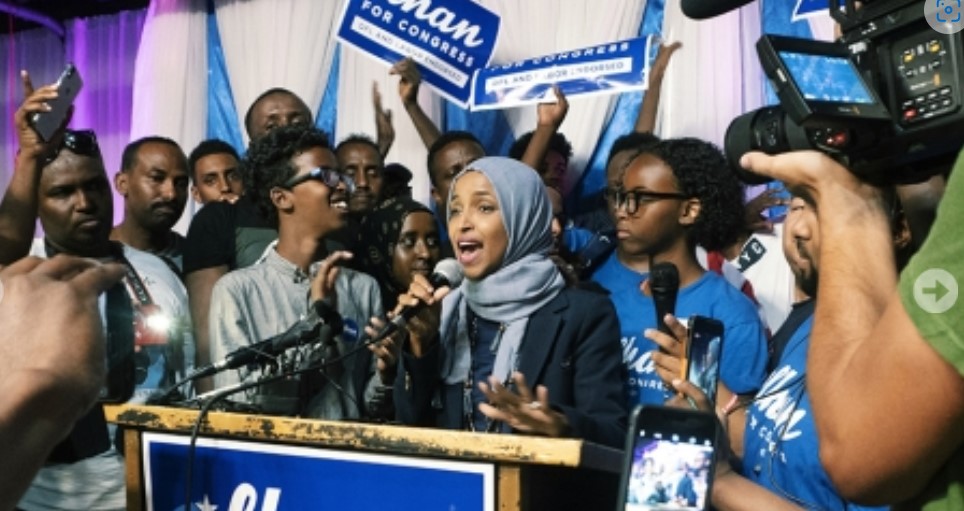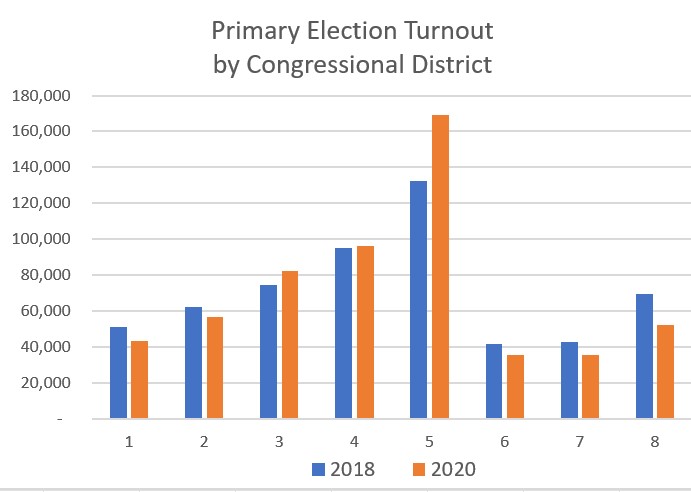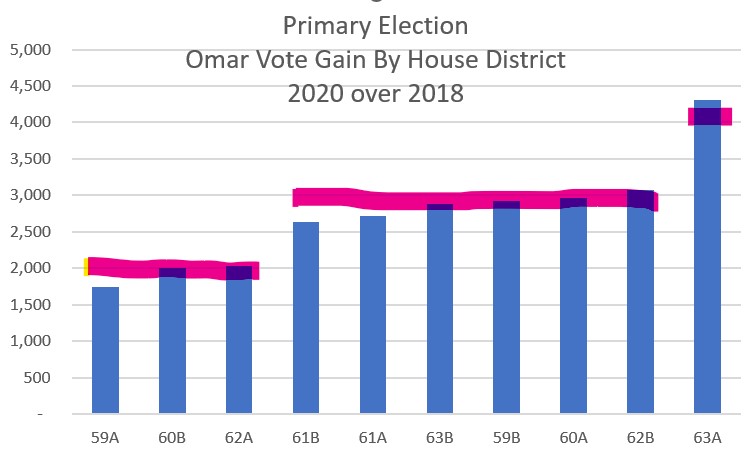The curiously precise Ilhan Omar vote machine
Congresswoman Ilhan Omar’s ability to turn out the vote has been remarkable over her brief career in politics. It will be tested again next month.
Early voting is already underway in the August 9 primary election in Minnesota. The primary election will determine which candidates will appear on the general election ballot in November.
During this mid-term election, the high-profile races are for governor and attorney general. All eight members of congress and all 201 members of the state legislature will be on the ballot this year.
On the Democratic side, most incumbents are running in next-month’s primary with little or no opposition. The one exception is in the Fifth Congressional District, where incumbent Ilhan Omar is running for a third term to represent this Minneapolis-centered constituency.
The Fifth District is the most Democratic leaning in Minnesota, with a partisan index of D+29. In fact, it ranks up there with the most Democratic-leaning districts in America. Whoever wins the Democratic primary in August is all but guaranteed to win the general election in November.
At the time she was a state representative, Omar first won election to U.S. Congress in 2018, after incumbent Keith Ellison decided to run for state Attorney General. She prevailed in a six-candidate field in the August 2018 primary with 48 percent of the vote, an 18-point victory over the second-place finisher, former state Speaker of the House Margaret Anderson-Kelliher.

In 2020, the incumbent Omar was challenged in the primary by local attorney Anton Mellon-Meaux and three other candidates. In that race, she achieved a 20-point victory over her closest rival.
In 2022, it’s again a five-way race in the Democratic primary. Her main rival this year is former Minneapolis City Council-member Don Samuels.
Local political commentator Blois Olson reported on the race in his Morning Take newsletter this morning, noting that Samuels is beginning to run ads against Omar. Here’s Olson’s take on the race:
It’s tough to measure the interest and sense of the CD5 DFL primary between Rep. Ilhan Omar and Don Samuels. One reason is because despite a visible, well-funded campaign in 2020, Antone Melton-Meaux was defeated solidly by Omar. The incumbent did that by running up the vote totals in Minneapolis. Melton-Meaux won in the suburbs, that had much lower turnout. There were about 101K votes cast just in Minneapolis in the 2020 primary, most of which were mail-in ballots. Total primary voters in 2020 was 179K. In the 2018 DFL primary, there were about 135K voters, and that was a competitive Governor’s race. The new dynamic in 2022 is that there are primaries in the Hennepin County Sheriff and Hennepin County Attorney’s office. In those races, motivated voters from the suburbs are likely to lean more toward Samuels. In every election turnout matters, in this election where the turnout is will be the difference.
As Olson notes, the 2020 primary election was remarkable in a number of aspects. The first was the size of the turnout. Turnout was higher in the Fifth district than any other part of the state, with a huge increase over the 2018 primary.

The above graph shows the number of Democrats voting in the U.S. Senate primary for the seat held by Sen. Tina Smith, the only statewide race common to both years.
In 2020, 169,000 Democrat voters cast ballots in the Fifth district in the Senate race.
In 2020, 178,000 Democrats voted in the race for Congress in the Fifth District. In other words, 9,000 Democrats skipped the line for Sen. Smith’s race and voted in the Omar race.
The total number of votes cast in 2020 increased by just under 43,000. Of these extra votes, Omar received over 38,000, some 90 percent of the increased vote total.
As Olson points out, Omar’s impressive vote gains were almost entirely within the Minneapolis part of the district. In other words, new Omar voters were almost entirely responsible for the increase in voter turnout, and almost all of the increased voter turnout occurred within the city limits of Minneapolis.
Where in Minneapolis? Curiously, Omar’s increased vote totals were evenly spread across the city. Almost perfectly evenly.
One would have expected her impressive vote gains to have been concentrated in those areas where she was already popular, such as her old house district 60B. That was not the case in 2020.
The Minnesota Secretary of State reports vote totals in a number of ways, including by state House of Representative Districts. Inside Minneapolis, there are 8 state house districts (including 60B) that lie almost entirely within the city. These 8 districts account for the bulk of Omar’s increased vote totals in 2020. Vote increases are shown by house district on the following graph,

Not only are the vote increases evenly spread across the city, they come in round-number chunks. By district, vote increases come in denominations of 2,000, 3,000, or 4,000, give or take a few votes.
As Olson points out, the 2020 primary contest was mostly conducted by mail. We will see over the next month whether that will be the case in 2022.